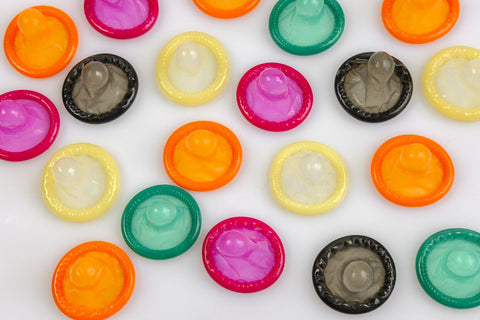When you are looking to get intimate, whether it’s with a partner or a casual acquaintance, being protected is incredibly important. One of the easiest, most affordable, and most effective ways to prevent unwanted STDs and pregnancies, as well as spice up your sex life in the process, is by using a condom — which comes in all shapes and sizes. But how effective are condoms? This guide has been created to tell you everything you need to know about the effectiveness of condoms, the importance of using them, and how you can use them easily and securely. Read on now for the complete overview.
We will cover:
- What Is a Condom?
- Different Types of Condoms and Materials
- How Effective Are Condoms?
- What Are the Risks of Using a Condom?
- What Are the Benefits of Using Condoms?
- When to See a Healthcare Provider?
What Is a Condom?
A condom is a sheath-shaped device that is designed to minimize the risk of sexually transmitted infection (STI) or pregnancy during sexual intercourse. They are usually made from latex, as well as polyurethane, polyisoprene, or even lamb intestine. Condoms have been around for hundreds of years as a form of safer sex and were added to the WHO’s list of essential medicines in 19871.
Commonly speaking, condoms refer to the external device that men roll onto their erect penis before intercourse, but there are female/internal condoms as well which are inserted inside the vagina or anus before sexual intercourse as well. Condoms can also be used for safer blowjobs too! This article will refer to male condoms as they are more commonly used.
Why Should You Use It?
The reason for using a condom is not just one of comfort and safety. It’s also a question of basic medicine. If you do not want to contract a nasty sexual infection, such as gonorrhea, chlamydia, or even HIV, then wrapping up your member is the best way to help prevent it from happening. According to the CDC, besides having no sex at all (and who wants that!?), the best way to help prevent an infection is by using a condom2. The same goes for unwanted pregnancies.
How to Put on Condoms?
Condoms are only effective if you use them correctly. This might seem daunting at first, but using them correctly is actually pretty simple. Simply follow the steps outlined below to make the best use of your condom:
- Read the instructions included with the condom
- Open the wrapper carefully to remove the condom without piercing it
- Place the condom on the top of the erect penis; uncircumcised men need to pull their foreskin back first
- Pinch the air out of the tip of the condom
- Once the condom is on, unroll it until it reaches the base of the penis
- Double-check that the condom is on securely
- Enjoy sexual intercourse!
It’s important to make sure that you are hard before sexual intercourse, so engage in some kissing, oral play, or manual stimulation to get your penis ready for condom usage.
Different Types of Condoms and Materials
Condoms come in all shapes and sizes, perfect when it comes to figuring out the best fit for your penis length or girth, as well as your preferred comfort level. The broad majority of condoms are made out of latex at 80%4, while most other condoms are made of synthetic materials such as polyurethane and polyisoprene. A small percentage is made from natural membranes, such as lambskin. In addition, there are a whole host of textures to choose from, including ribbed and studded, as well as condoms in different flavors and feels. It’s worth taking a long and extensive look at the different condoms on offer to find the right one for you and your partner.
How Effective Are Condoms?
Now that you understand a bit more, it’s worth asking yourself: how effective are condoms, both in theory and in practice? As previously stated, condoms are one of the most effective and most recommended ways to protect yourself from both STDs and pregnancy when having sex. In fact, condoms are the only method of protection that works against both cases simultaneously. In the subsequent sections, we will dig into the statistics behind the effectiveness against STDs and pregnancy respectively. The important part to know is that these stats only count towards condom usage when used correctly. If you use condoms incorrectly, this will greatly reduce the chances of them working to full effectiveness.
How Effective Are Condoms Against STDs?
Condoms are highly effective against bacterial and viral STDs. According to a metastudy, condoms offer over 90% protection against gonorrhea, 50-90% protection against chlamydia, 90% protection against HIV, and 90% against Hepatitis B. Unfortunately, the protection of transmission of genital herpes is only 40%5. If you want to understand more, it’s worth learning these 5 things to know about STIs.
How Effective Are Condoms Against Pregnancy?
Condoms are highly effective when it comes to preventing pregnancy. In fact, according to the WHO, 98% of women whose male partners use condoms are protected from pregnancy1. This can be contrasted with the far higher risk of becoming pregnant from a single round of unprotected sex, coming in between 3-10%6.
What Are the Risks of Using a Condom?
As stated above, when using condoms correctly, the risk of infection is greatly lessened, meaning that it’s a no-brainer when it comes to safe and exciting sex. There are two risks that you need to be aware of: breakage (rendering the condom useless) and slippage (when the condom falls off). This depends upon proper usage and finding the right condom, so make sure you read this guide carefully and find the perfect fit for you before having sex.
What Are the Benefits of Using Condoms?
Condoms come with many benefits, including reducing the risk of contracting an STI and the risk of becoming pregnant. Another benefit of practicing safe sex in this fashion is that it puts both men and women at ease before and after the session, as they don’t have to worry about anything during sex apart from pleasing one another. The other benefit as opposed to, for example, the pill, is that you only have to pay per the amount of condoms that you use, saving you money. Some condom users have sensitivity to latex. If this is the case, then it is recommended to switch to non-latex condoms.
When to See a Healthcare Provider?
If you use condoms correctly, you should have little to worry about. However, minimal risk is not the same as zero risk, meaning that there is still a small chance of something going wrong. Iif you feel like you are displaying any signs of an STIs, such as irritation or a burning sensation when you pee, then it is absolutely recommended to see a healthcare professional. Additionally, any women who exhibit any telltale signs of pregnancy, such as missing their period, or throwing up in the morning, should certainly visit a gynecologist as soon as they can. It’s also deeply important to get checked for STIs after each new partner!
Resources
- WHO, Undated, Condoms
- CDC, 2023, How You Can Prevent Sexually Transmitted Diseases
- CDC, 2023, U.S. Pregnancy Rates Drop During Last Decade
- National Institute of Health, 2023, Condoms
- National Institute of Health, 2015, Condoms: Past, present, and future
- National Institute of Health, 2021, Perceived likelihood of becoming pregnant and contraceptive use: Findings from population-based surveys in Côte d'Ivoire, Nigeria, and Rajasthan, India
- National Instute of Health, 1993, How often do condoms break or slip off in use?








